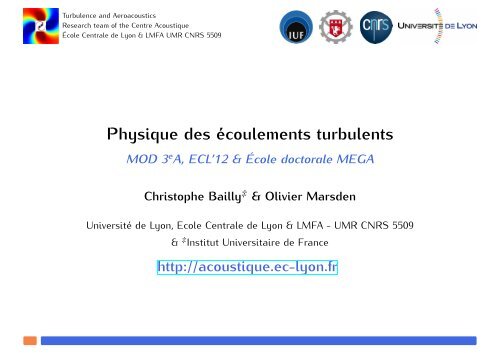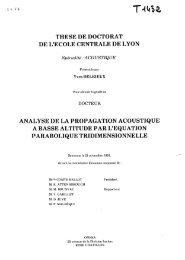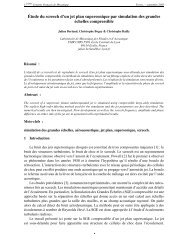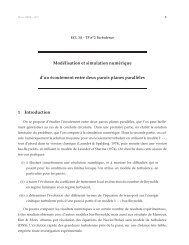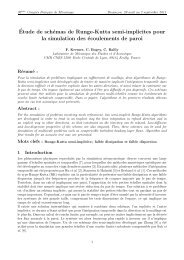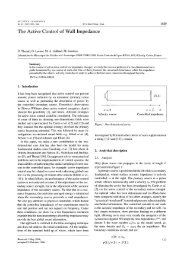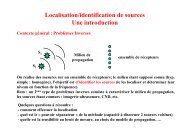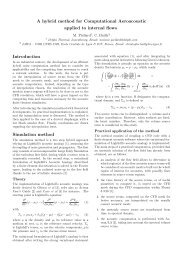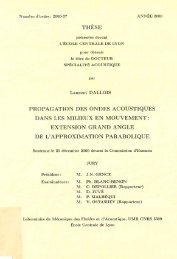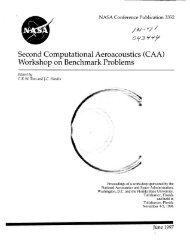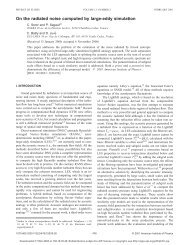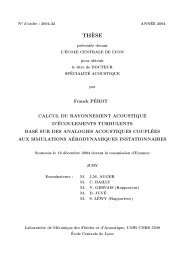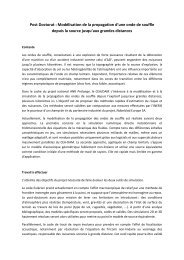Physique des écoulements turbulents - Centre Acoustique du LMFA ...
Physique des écoulements turbulents - Centre Acoustique du LMFA ...
Physique des écoulements turbulents - Centre Acoustique du LMFA ...
Create successful ePaper yourself
Turn your PDF publications into a flip-book with our unique Google optimized e-Paper software.
Turbulence and Aeroacoustics<br />
Research team of the <strong>Centre</strong> <strong>Acoustique</strong><br />
École Centrale de Lyon & <strong>LMFA</strong> UMR CNRS 5509<br />
<strong>Physique</strong> <strong>des</strong> <strong>écoulements</strong> <strong>turbulents</strong><br />
MOD 3 e A, ECL’12 & École doctorale MEGA<br />
Christophe Bailly ‡ & Olivier Marsden<br />
Université de Lyon, Ecole Centrale de Lyon & <strong>LMFA</strong> - UMR CNRS 5509<br />
& ‡ Institut Universitaire de France<br />
http://acoustique.ec-lyon.fr
1<br />
Écoulements <strong>turbulents</strong><br />
apparence très désordonnée<br />
comportement non prévisible<br />
A short intro<strong>du</strong>ction to turbulent flows <br />
existence de nombreuses échelles spatiales et temporelles<br />
La turbulence apparaît lorsque la source d’énergie qui met le fluide en mouvement<br />
est suffisamment intense devant les effets visqueux que le fluide oppose<br />
pour se déplacer.<br />
- astrophysique, <strong>écoulements</strong> géophysiques, aérodynamique externe<br />
(aéronautique & transports terrestres), combustion, pro<strong>du</strong>ction<br />
d’énergie, génie <strong>des</strong> procédés, biomécanique, ...<br />
- source de bruit (aéroacoustique), propagation <strong>des</strong> on<strong>des</strong>, couplage<br />
fluide - structure, ...<br />
<strong>Physique</strong> <strong>des</strong> <strong>écoulements</strong> <strong>turbulents</strong> @ Christophe Bailly – ECL’12
2<br />
A short intro<strong>du</strong>ction to turbulent flows <br />
Simulation d’une région de l’Univers de 500 millions d’années-lumière de côté<br />
‘Horizon project’, Cosmological hydrodynamics<br />
Institut d’Astrophysique de Paris (Pichon) & CEA (Teyssier)<br />
<strong>Physique</strong> <strong>des</strong> <strong>écoulements</strong> <strong>turbulents</strong> @ Christophe Bailly – ECL’12<br />
Numerical simulation of structure<br />
formation in an expanding<br />
universe : N body simulation<br />
(red temperature) with 70 billions<br />
particles
3<br />
A short intro<strong>du</strong>ction to turbulent flows <br />
Images satellites : météorologie www.meteofrance.com<br />
<strong>Physique</strong> <strong>des</strong> <strong>écoulements</strong> <strong>turbulents</strong> @ Christophe Bailly – ECL’12<br />
www.meteo-lyon.net
4<br />
Cyclone Ivan - 13 sept. 2004 - catégorie 5<br />
A short intro<strong>du</strong>ction to turbulent flows <br />
Cyclone Ivan menançant Cuba et la Floride, progressant à une vitesse de<br />
14 km/h avec <strong>des</strong> vents à 260 km/h et <strong>des</strong> rafales à plus de 354 km/h<br />
<strong>Physique</strong> <strong>des</strong> <strong>écoulements</strong> <strong>turbulents</strong> @ Christophe Bailly – ECL’12
5<br />
Cyclone Katrina - sept. 2005 - catégorie 5<br />
A short intro<strong>du</strong>ction to turbulent flows <br />
vents de 280 km/h en rafale (moyenne sur 1 minute aux USA)<br />
80% de la Nouvelle-Orléans innondée, see Dixon et al., 2006, Nature, 441,<br />
586-587<br />
<strong>Physique</strong> <strong>des</strong> <strong>écoulements</strong> <strong>turbulents</strong> @ Christophe Bailly – ECL’12
6<br />
A short intro<strong>du</strong>ction to turbulent flows <br />
Earth’s surface temperature expressed as anomaly from 1961-90<br />
(data from www.cru.uea.ac.uk)<br />
∆T (deg. C)<br />
0.6<br />
0.4<br />
0.2<br />
0<br />
−0.2<br />
−0.4<br />
−0.6<br />
−0.8<br />
1850 1900 1950 2000<br />
year<br />
Over both the last 140 years and 100 years, the best estimate is that the global<br />
average surface temperature has increased by 0.6 ± 0.2 o C.<br />
<strong>Physique</strong> <strong>des</strong> <strong>écoulements</strong> <strong>turbulents</strong> @ Christophe Bailly – ECL’12
7<br />
A short intro<strong>du</strong>ction to turbulent flows <br />
Near-surface wind speeds 10 meters above the Atlantic Ocean<br />
Data collected by the SeaWinds scatterometer on-board NASA’s QuikSCAT satellite<br />
(NASA’s Jet Propulsion Laboratory)<br />
<strong>Physique</strong> <strong>des</strong> <strong>écoulements</strong> <strong>turbulents</strong> @ Christophe Bailly – ECL’12
8<br />
Jupiter’s Great Red Spot (NASA)<br />
A short intro<strong>du</strong>ction to turbulent flows <br />
<strong>Physique</strong> <strong>des</strong> <strong>écoulements</strong> <strong>turbulents</strong> @ Christophe Bailly – ECL’12
9<br />
A short intro<strong>du</strong>ction to turbulent flows <br />
Eruption of the subglacial Grimsvötn volcano, Iceland, on 21 May 2011<br />
An initial large plume of smoke and ash rose up to about 17 km height.<br />
Courtesy of Thördïs Högnadóttir, Institute of Earth Sciences, University of Iceland<br />
<strong>Physique</strong> <strong>des</strong> <strong>écoulements</strong> <strong>turbulents</strong> @ Christophe Bailly – ECL’12
10<br />
Hydrodynamics<br />
A short intro<strong>du</strong>ction to turbulent flows <br />
<strong>Physique</strong> <strong>des</strong> <strong>écoulements</strong> <strong>turbulents</strong> @ Christophe Bailly – ECL’12
11<br />
Aeronautics<br />
Tip vortex behind an airplane<br />
A short intro<strong>du</strong>ction to turbulent flows <br />
<strong>Physique</strong> <strong>des</strong> <strong>écoulements</strong> <strong>turbulents</strong> @ Christophe Bailly – ECL’12<br />
Fleet Air Arm Corsair III in 1944,<br />
(unintended) visualization of the<br />
propeller wake<br />
Boeing 767-370/ER
12<br />
A short intro<strong>du</strong>ction to turbulent flows <br />
Expérience de Reynolds (1883) : régime laminaire / régime turbulent<br />
<strong>Physique</strong> <strong>des</strong> <strong>écoulements</strong> <strong>turbulents</strong> @ Christophe Bailly – ECL’12
13<br />
Paramètre de contrôle : nombre de Reynolds<br />
ReD =<br />
A short intro<strong>du</strong>ction to turbulent flows <br />
temps diffusion<br />
temps convection ∼ D2 /ν<br />
D/Ud<br />
transition laminaire - turbulent pour ReD = ρUdD<br />
µ = UdD<br />
D ∼ distance caractéristique cisaillement<br />
On doit à Boussinesq (1872, 1877) et<br />
à Reynolds (1883, 1894) cette définition<br />
d’un régime turbulent par opposition<br />
à un régime laminaire.<br />
Osborn Reynolds<br />
(1842-1912)<br />
<strong>Physique</strong> <strong>des</strong> <strong>écoulements</strong> <strong>turbulents</strong> @ Christophe Bailly – ECL’12<br />
ν<br />
∼ 2300<br />
Joseph Boussinesq<br />
(1842-1929)
14<br />
Skin-friction coefficient Cf for a circular pipe<br />
Cf<br />
10 0<br />
10 −1<br />
10 −2<br />
10 −3<br />
10 0<br />
10 2<br />
10 4<br />
ReD = UdD/ν<br />
laminar regime Cf = 16/ReD<br />
A short intro<strong>du</strong>ction to turbulent flows <br />
10 6<br />
Blasius’ relationship, Cf ≃ 0.0791 Re −1/4<br />
D<br />
1/C 1/2<br />
f<br />
≃ 3.860 log 10 (ReD C 1/2<br />
f ) − 0.088<br />
10 8<br />
<strong>Physique</strong> <strong>des</strong> <strong>écoulements</strong> <strong>turbulents</strong> @ Christophe Bailly – ECL’12<br />
• Oregon facility<br />
Princeton Superpipe<br />
McKeon et al. (2004)
15<br />
A short intro<strong>du</strong>ction to turbulent flows <br />
Relation between the skin-friction coefficient Cf and the friction coefficient ψ<br />
(coefficient de frottement local et coefficient de perte de charges)<br />
p1<br />
τw = µ dU<br />
dr<br />
✻<br />
❄<br />
D<br />
<br />
<br />
<br />
<br />
r=R<br />
∆p ≡ p1 − p2 = 4cf<br />
p2<br />
Cf ≡ τw<br />
1<br />
2 ρU2 d<br />
<br />
Σ<br />
∆p ≡ ψ L<br />
D<br />
<br />
ρu·(u · n) dΣ = −<br />
0 = (−p1 + p2) πD2<br />
4<br />
L 1<br />
D 2 ρU2 d = ψ L 1<br />
D 2 ρU2 d<br />
<strong>Physique</strong> <strong>des</strong> <strong>écoulements</strong> <strong>turbulents</strong> @ Christophe Bailly – ECL’12<br />
Σ<br />
1<br />
2 ρU2 d<br />
<br />
pndΣ+ τ(n)dΣ<br />
Σ<br />
+ πDL µdU<br />
dr<br />
ψ ≡ 4cf<br />
<br />
<br />
<br />
<br />
r=R
16<br />
A short intro<strong>du</strong>ction to turbulent flows <br />
Zero-pressure-gradient boundary layer on a flat plate<br />
x2<br />
O<br />
∂U1<br />
U1<br />
∂x1<br />
✻<br />
❍❍<br />
∂U1<br />
+ U2<br />
∂x2<br />
L<br />
δ<br />
✻<br />
✲<br />
∼ ν ∂2 U1<br />
∂x 2 2<br />
Ue1<br />
convection molecular diffusion<br />
δ<br />
L ∼<br />
1<br />
√ UL/ν<br />
✲<br />
✲<br />
✲<br />
✲<br />
✲<br />
U1 (x2)<br />
U 2<br />
L<br />
∼ ν U<br />
δ 2<br />
parabolic laminar boundary layer<br />
<strong>Physique</strong> <strong>des</strong> <strong>écoulements</strong> <strong>turbulents</strong> @ Christophe Bailly – ECL’12<br />
✲<br />
x1<br />
δ2 ν<br />
∼<br />
L2 UL
17<br />
A short intro<strong>du</strong>ction to turbulent flows <br />
Couche limite laminaire : solution autosimilaire de Blasius (1908)<br />
δ<br />
x1<br />
≃ 4.92<br />
δ ≃ 4.92<br />
1<br />
Rex 1<br />
νx1<br />
Ue1<br />
x 2 /δ<br />
1.5<br />
1.0<br />
0.5<br />
Coefficient de frottement local,<br />
Cf = τw<br />
1<br />
2 ρU2 e1<br />
0.0 0.2 0.4 0.6 0.8 1.0<br />
U /U<br />
1 e1<br />
∼ µU<br />
δ<br />
ρU<br />
2 ∼ ν<br />
δU<br />
∼ 1<br />
Re 1/2<br />
L<br />
<strong>Physique</strong> <strong>des</strong> <strong>écoulements</strong> <strong>turbulents</strong> @ Christophe Bailly – ECL’12<br />
H. Blasius (1883-1970)<br />
Cf ≃ 0.664<br />
Rex 1
18<br />
Couche limite : transition<br />
A short intro<strong>du</strong>ction to turbulent flows <br />
Le régime laminaire est observé jusqu’à un nombre de Reynolds critique d’environ<br />
Rex 1 = x1Ue1<br />
ν<br />
≃ 3.2 × 105<br />
soit encore, pour un nombre de Reynolds construit sur l’épaisseur de la couche<br />
limite δ, Reδ = δUe1/ν ≃ 2800.<br />
turbulent spot growing by <strong>des</strong>tabilizing the<br />
surrounding laminar flow<br />
<strong>Physique</strong> <strong>des</strong> <strong>écoulements</strong> <strong>turbulents</strong> @ Christophe Bailly – ECL’12<br />
visualization by laser-in<strong>du</strong>ced fluorescence (LIF)<br />
Gad-el-Hak et al. (1981)
19<br />
Turbulent boundary layer<br />
F. Laadhari (<strong>LMFA</strong>)<br />
A short intro<strong>du</strong>ction to turbulent flows <br />
Reδ θ ≃ 1000 Ue1 = 2.1 m.s −1 δ ≃ 7 cm uτ ≃ 0.1 m.s −1 x1 ≃ 3 m<br />
temps convection<br />
L<br />
U<br />
✲<br />
convection<br />
∼ δ<br />
u ′ temps diffusion turbulente<br />
Typiquement u ′ /Ue1 ∼ 10 −2 , difficile d’estimer Cf dimensionnellement.<br />
<strong>Physique</strong> <strong>des</strong> <strong>écoulements</strong> <strong>turbulents</strong> @ Christophe Bailly – ECL’12<br />
✻<br />
diffusion<br />
turbulente
20<br />
Automotive in<strong>du</strong>stry<br />
A short intro<strong>du</strong>ction to turbulent flows <br />
<strong>Physique</strong> <strong>des</strong> <strong>écoulements</strong> <strong>turbulents</strong> @ Christophe Bailly – ECL’12<br />
Posson & Pérot, AIAA Paper 2006-2719
21<br />
A short intro<strong>du</strong>ction to turbulent flows <br />
Free shear flows : subsonic turbulent jets Reynolds number ReD = ujD/ν<br />
Prasad & Sreenivasan (1989)<br />
ReD ≃ 4000<br />
Kurima, Kasagi & Hirata (1983)<br />
ReD ≃ 5.6 × 10 3<br />
Ayrault, Balint & Schon (1981)<br />
ReD ≃ 1.1 × 10 4<br />
Dimotakis et al. (1983)<br />
ReD ≃ 10 4<br />
<strong>Physique</strong> <strong>des</strong> <strong>écoulements</strong> <strong>turbulents</strong> @ Christophe Bailly – ECL’12<br />
Mollo-Christensen (1963)<br />
ReD = 4.6 × 10 5
22<br />
Free shear flows : jets<br />
visualization with smoke wires<br />
ReD ≃ 5.4 × 10 4<br />
Courtesy of H. Fiedler (1987)<br />
A short intro<strong>du</strong>ction to turbulent flows <br />
entrainment by a turbulent round jet from a wall<br />
ReD = 10 6<br />
Florent, J. Méc. (1965)<br />
<strong>Physique</strong> <strong>des</strong> <strong>écoulements</strong> <strong>turbulents</strong> @ Christophe Bailly – ECL’12
23<br />
A short intro<strong>du</strong>ction to turbulent flows <br />
Free shear flows : wake behind a circular cylinder / Karman vortex street<br />
ReD = 0.16 ReD = 1.54<br />
ReD = 26 ReD = 138<br />
<strong>Physique</strong> <strong>des</strong> <strong>écoulements</strong> <strong>turbulents</strong> @ Christophe Bailly – ECL’12
24<br />
A short intro<strong>du</strong>ction to turbulent flows <br />
Free shear flows : wake behind a circular cylinder / Karman vortex street<br />
Van Dyke, An album of fluid motion<br />
ONERA - DAFE<br />
ReD = 140 ReD = 10000<br />
<strong>Physique</strong> <strong>des</strong> <strong>écoulements</strong> <strong>turbulents</strong> @ Christophe Bailly – ECL’12
A short intro<strong>du</strong>ction to turbulent flows <br />
Free shear flows : wake behind a circular cylinder / Karman vortex street<br />
Alexander Selkirk Island in the southern<br />
Pacific Ocean.<br />
25<br />
←<br />
→<br />
These Karman vortices formed over the<br />
islands of Broutona, Chirpoy, and Brat<br />
Chirpoyev ("Chirpoy’s Brother"), all part<br />
of the Kuril Island chain found between<br />
Russia’s Kamchatka Peninsula and Ja-<br />
pan.<br />
<strong>Physique</strong> <strong>des</strong> <strong>écoulements</strong> <strong>turbulents</strong> @ Christophe Bailly – ECL’12
26<br />
Free shear flows : wakes<br />
A short intro<strong>du</strong>ction to turbulent flows <br />
Béguier & Fraunié, Int. J. of Heat and Mass Transfert (1991)<br />
<strong>Physique</strong> <strong>des</strong> <strong>écoulements</strong> <strong>turbulents</strong> @ Christophe Bailly – ECL’12
27<br />
Non-linéarité <strong>des</strong> équations de Navier-Stokes<br />
ρ<br />
∂u<br />
∂t<br />
A short intro<strong>du</strong>ction to turbulent flows <br />
<br />
+ u · ∇u<br />
= −∇p + µ∇ 2 u<br />
Le terme d’accélération convective u · ∇u est à l’origine <strong>des</strong> nombreuses échelles<br />
que l’on observe dans un écoulement turbulent<br />
Petit exemple illustrant la création d’harmoniques. En notant u = (u, v)<br />
⎧<br />
⎪⎨<br />
⎪⎩<br />
∂u<br />
∂t<br />
∂v<br />
∂t<br />
+ u∂u<br />
∂x<br />
+ u∂v<br />
∂x<br />
+ v ∂u<br />
∂y<br />
+ v ∂v<br />
∂y<br />
= 0<br />
= 0<br />
avec<br />
⎧<br />
⎪⎨<br />
<strong>Physique</strong> <strong>des</strong> <strong>écoulements</strong> <strong>turbulents</strong> @ Christophe Bailly – ECL’12<br />
⎪⎩<br />
u (x, y, t0) = A cos(kxx) cos(kyy)<br />
v (x, y, t0) = A ′ cos(k ′ x x) cos(k′ y y)
28<br />
Non-linéarité <strong>des</strong> équations de Navier-Stokes<br />
A short intro<strong>du</strong>ction to turbulent flows <br />
u (x, y, t) = u (x, y, t0) + (t − t0) ∂u<br />
<br />
<br />
<br />
∂t<br />
<br />
∂u<br />
= − u<br />
∂t<br />
∂u<br />
<br />
∂u<br />
+ v<br />
∂x ∂y<br />
u (x, y, t) = A cos(kxx) cos(kyy) + (t − t0)<br />
kyAA ′<br />
t0<br />
kxA 2<br />
4<br />
t 0<br />
t0<br />
+ ...<br />
sin(2kxx) cos(2kyy) + 1 <br />
+ (t − t0) {cos [(kx − k<br />
4<br />
′ x)x] + cos [(kx + k ′ x)x]}<br />
× sin (ky − k ′ y)y + sin (ky + k ′ y)y + ...<br />
On observe la création d’harmoniques supérieures, i.e. de grands nombres d’onde<br />
ou bien encore de petites structures, et aussi la création de sous-harmoniques.<br />
Limite pour la taille <strong>des</strong> plus grands nombres d’onde ou <strong>des</strong> plus petites structures<br />
dans un écoulement turbulent ?<br />
<strong>Physique</strong> <strong>des</strong> <strong>écoulements</strong> <strong>turbulents</strong> @ Christophe Bailly – ECL’12
29<br />
Non-linéarité <strong>des</strong> équations de Navier-Stokes<br />
A short intro<strong>du</strong>ction to turbulent flows <br />
Le transfert vers les grands nombres d’onde est limité par la viscosité moléculaire :<br />
les particules flui<strong>des</strong> ne peuvent conserver leur différence de vitesse.<br />
E(k) spectrum<br />
energy injection at t 0<br />
k η<br />
Plus petites structures : uη kη ∼ 1/lη<br />
∂u<br />
∂t ≃ ν∇2 u (Stokes)<br />
∂u<br />
∂t ∼ u2 η<br />
lη<br />
Reη = lηuη<br />
ν<br />
ν∇ 2 u ∼ ν uη<br />
l 2 η<br />
Ces échelles (uη, lη) de Kolmogorov, plus petites échelles avant dissipation, ont<br />
un rôle très important.<br />
<strong>Physique</strong> <strong>des</strong> <strong>écoulements</strong> <strong>turbulents</strong> @ Christophe Bailly – ECL’12<br />
∼ 1
30<br />
A short intro<strong>du</strong>ction to turbulent flows <br />
La turbulence est bien <strong>du</strong> ressort de la mécanique <strong>des</strong> milieux continus<br />
lη / λl ? (libre parcours moyen)<br />
nombre de Knudsen Kn = λl<br />
lη<br />
≪ 1<br />
La non-linéarité <strong>des</strong> équations de Navier-Stokes ne permet pas de prévoir l’évolution<br />
<strong>du</strong> champ turbulent sur <strong>des</strong> temps très longs : sensibilité aux conditions<br />
initiales<br />
(liée à la valeur <strong>du</strong> plus grand exposant de Lyapunov pour les systèmes dynamiques<br />
chaotiques)<br />
Dans l’atmosphère, on estime que deux particules flui<strong>des</strong> distantes de 10 cm se<br />
retrouvent séparées d’environ 10 km en une journée, « effet papillon ».<br />
<strong>Physique</strong> <strong>des</strong> <strong>écoulements</strong> <strong>turbulents</strong> @ Christophe Bailly – ECL’12
31<br />
Blinking vortex flow of Aref (1984)<br />
x 2 /a<br />
x 2 /a<br />
x 2 /a<br />
0.8<br />
0<br />
−0.8<br />
−1.6 −0.8 0<br />
x /a<br />
1<br />
0.8 1.6<br />
0.8<br />
0<br />
−0.8<br />
−1.6 −0.8 0<br />
x /a<br />
1<br />
0.8 1.6<br />
0.8<br />
0<br />
−0.8<br />
−1.6 −0.8 0<br />
x /a<br />
1<br />
0.8 1.6<br />
A short intro<strong>du</strong>ction to turbulent flows <br />
β = 0.01<br />
β = 0.25<br />
β = 0.40<br />
<strong>Physique</strong> <strong>des</strong> <strong>écoulements</strong> <strong>turbulents</strong> @ Christophe Bailly – ECL’12<br />
for 0 ≤ t ≤ T , vortex (−a, 0) on<br />
for T ≤ t ≤ 2T , vortex (a, 0) on<br />
Γ ✲<br />
✛<br />
2a<br />
Γ ✲<br />
control parameter : β = ΓT<br />
2πa 2<br />
chaos in Hamiltonian systems<br />
(mixing in fluids)<br />
✲
32<br />
Role of pressure<br />
Taking the divergence of the Navier-Stokes equations,<br />
∂<br />
∂xi<br />
<br />
ρ<br />
∂ui<br />
∂t<br />
<br />
∂ui<br />
+ uj<br />
∂xj<br />
A short intro<strong>du</strong>ction to turbulent flows <br />
= − ∂p<br />
∂xi<br />
and p satisfies the Poisson equation,<br />
∇ 2 p = −ρ ∂<br />
∂xi<br />
<br />
uj<br />
+ µ ∂2 ui<br />
∂x 2 j<br />
<br />
∂ui<br />
∂xj<br />
<br />
= −ρ ∂ui<br />
∂xj<br />
ρ = cst ∇ · u = 0<br />
The solution can be explicitly written as, (if p → cst as r → ∞)<br />
p (x) = ρ<br />
4π<br />
<br />
V<br />
∂ui ∂uj<br />
∂yj<br />
∂yi<br />
(y) dy<br />
r<br />
∂uj<br />
∂xi<br />
where r = x − y<br />
Note that all the points y in the volume V contribute to the pressure at the point<br />
x, nonlocal relation between velocity and pressure<br />
<strong>Physique</strong> <strong>des</strong> <strong>écoulements</strong> <strong>turbulents</strong> @ Christophe Bailly – ECL’12
33<br />
Outline of the course <br />
Découvrir et comprendre la physique <strong>des</strong> <strong>écoulements</strong> <strong>turbulents</strong><br />
Établir les bases pour une <strong>des</strong>cription statistique indispensable à la modélisation<br />
Donner un aperçu assez large et pratique de la simulation numérique et <strong>des</strong><br />
techniques expérimentales pour les <strong>écoulements</strong> <strong>turbulents</strong><br />
intro<strong>du</strong>ction aux <strong>écoulements</strong> <strong>turbulents</strong><br />
<strong>des</strong>cription statistique<br />
<strong>écoulements</strong> de paroi<br />
dynamique <strong>du</strong> tourbillon<br />
turbulence homogène et isotrope - théorie de Kolmogorov<br />
aperçu sur la simulation numérique et les techniques expérimentales<br />
<strong>Physique</strong> <strong>des</strong> <strong>écoulements</strong> <strong>turbulents</strong> @ Christophe Bailly – ECL’12
34<br />
Activités pratiques<br />
Organisation <strong>du</strong> cours - ECL <br />
TP-1 modélisation et simulation d’un écoulement de canal plan<br />
<strong>Centre</strong> <strong>Acoustique</strong> (KCA)<br />
séance supplémentaire (non inscrits ECL) le jeudi 8 novembre à 14h<br />
TP-2 anémométrie à fil chaud dans un jet libre<br />
Mécanique <strong>des</strong> flui<strong>des</strong> (I11)<br />
séance supplémentaire (non inscrits ECL) le jeudi 15 novembre à 14h<br />
BE – travaux dirigés en petite classe<br />
vendredi 14 décembre - 13h30<br />
Étudiants en master, auditeurs libres :<br />
possibilité de suivre ces activités pratiques : faites vous connaître !<br />
<strong>Physique</strong> <strong>des</strong> <strong>écoulements</strong> <strong>turbulents</strong> @ Christophe Bailly – ECL’12
35<br />
Contrôle <strong>des</strong> connaissances<br />
4 Exercices (dans une liste au choix 60%)<br />
+ travail BE (20%) + travaux pratiques (20%)<br />
Organisation <strong>du</strong> cours - ECL <br />
Gestion <strong>des</strong> absences : possible de modifier exceptionnellement une séance de<br />
TP uniquement en échangeant sa séance avec celle d’un autre étudiant.<br />
Examen écrit master (MEGA)<br />
Équipe d’enseignement : Benoît André<br />
Christophe Bailly<br />
Christophe Bogey<br />
Didier Dragna<br />
Olivier Marsden<br />
<strong>Physique</strong> <strong>des</strong> <strong>écoulements</strong> <strong>turbulents</strong> @ Christophe Bailly – ECL’12
36<br />
Organisation <strong>du</strong> cours - ECL <br />
Transparents à télécharger sur le site web <strong>du</strong> groupe <strong>Acoustique</strong>,<br />
http://acoustique.ec-lyon.fr<br />
merci de NE PAS envoyer vos travaux par mail !<br />
Site web à visiter aussi pour sujets de thèses, recherche au <strong>LMFA</strong>, ...<br />
<strong>Physique</strong> <strong>des</strong> <strong>écoulements</strong> <strong>turbulents</strong> @ Christophe Bailly – ECL’12
37<br />
Local textbook<br />
Some references <br />
Bailly, C. & Comte Bellot, G., 2003<br />
Turbulence<br />
CNRS éditions, Paris<br />
ISBN 2-271-06008-7<br />
376 pages, 114 figures, 622 references.<br />
en librairie, prix public : 39 euros<br />
En vente auprès <strong>des</strong> auteurs avec<br />
30% de ré<strong>du</strong>ction : 27,50e<br />
<strong>Physique</strong> <strong>des</strong> <strong>écoulements</strong> <strong>turbulents</strong> @ Christophe Bailly – ECL’12
38<br />
Textbooks<br />
A short intro<strong>du</strong>ction to turbulent flows <br />
Batchelor, G.K., 1967, An intro<strong>du</strong>ction to fluid dynamics, Cambridge University Press, Cambridge.<br />
Bailly C. & Comte Bellot G., 2003 Turbulence, CNRS éditions, Paris.<br />
Candel S., 1995, Mécanique <strong>des</strong> flui<strong>des</strong>, Dunod Université, 2nd édition, Paris.<br />
Davidson P.A., 2004, Turbulence. An intro<strong>du</strong>ction for scientists and engineers, Oxford University Press, Oxford.<br />
Davidson, P.A., Kaneda, Y., Moffatt, H.K. & Sreenivasan, K.R., Edts, 2011, A voyage through Turbulence, Cambridge<br />
University Press, Cambridge.<br />
Guyon E., Hulin J.P. & Petit L., 2001, Hydrodynamique physique, EDP Sciences / Editions <strong>du</strong> CNRS, première édition<br />
1991, Paris - Meudon.<br />
Hinze J.O., 1975, Turbulence, McGraw-Hill International Book Company, New York, 1 ère édition en 1959.<br />
Landau L. & Lifchitz E., 1971, Mécanique <strong>des</strong> flui<strong>des</strong>, Editions MIR, Moscou.<br />
Also Pergamon Press, 2nd edition, 1987.<br />
Lesieur M., 2008, Turbulence in fluids : stochastic and numerical modelling, Kluwer Academic Publishers, 4th revised<br />
and enlarged ed., Springer.<br />
Pope S.B., 2000, Turbulent flows, Cambridge University Press.<br />
Tennekes H. & Lumley J.L., 1972, A first course in turbulence, MIT Press, Cambridge, Massachussetts.<br />
Van Dyke M., 1982, An album of fluid motion, The Parabolic Press, Stanford, California.<br />
White F., 1991, Viscous flow, McGraw-Hill, Inc., New-York, first edition 1974.<br />
<strong>Physique</strong> <strong>des</strong> <strong>écoulements</strong> <strong>turbulents</strong> @ Christophe Bailly – ECL’12


